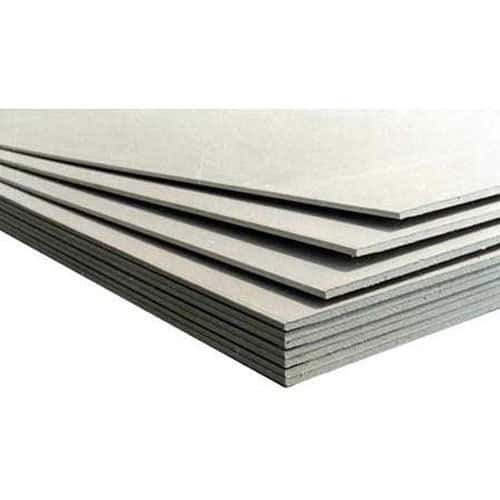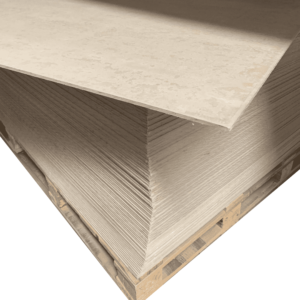The Licata multipurpose cement board is made using revolutionary HSPC technology. This unique technology makes these boards totally moisture, termite and fire resistant. These boards are ideal for residential, commercial and industrial usage.
Multi Purpose Fibre Cement Board range offers all the benefits listed below.
![]() BBA Approved.
BBA Approved.
![]() Easy to install and modification.
Easy to install and modification.
![]() Highly preferred building board by superior functional features for especially prefabricated and steel buildings.
Highly preferred building board by superior functional features for especially prefabricated and steel buildings.
![]() Protect the building from different weather conditions.
Protect the building from different weather conditions.
![]() Using as a backer board behind tiles on wet spaces.
Using as a backer board behind tiles on wet spaces.
![]() Resistant to biological and chemical wastes of animals.
Resistant to biological and chemical wastes of animals.
![]() Using as a sheathing board on floors and roofs.
Using as a sheathing board on floors and roofs.
Description
Multi Purpose Fibre Cement Board
Licata A1 Multipurpose is a highly versatile cellulose fibre cement building board, offering excellent strength, weathering and acoustic properties. It is available as building boards and soffit strips.
Features
- Excellent weathering properties
- Wide range of thicknesses
- Extensive range of applications
- High impact resistance
- light weight and easy to carry
Areas of Application
Interior
- Internal walls
- Floor / Raised floor
- Mezzanine floor
- Indoor ceilings
- Wet spaces
- Elevator shaft walls
Exterior
- External walls
- Roofs
- Outdoor ceilings
- Fences and boundary walls
What is fibre cement?
Fibre cement – often referred to as fibre reinforced cement – has been around for decades and has slowly gained favour in the construction industry. It is a composite building material comprised of cement that’s reinforced with cellulose. Fibre cement board from Licata demonstrates an array of notable characteristics that deserve a closer look.
Fire resistance
Every year more than 200 people lose their lives in house fires alone in the UK and many times that number are injured. For decades architects, builders, contractors, and regulators have been trying to find ways to improve the fire resistance of the average home. Fibre cement board fits that particular bill exceptionally well. It is a completely non-combustible building material.
Water resistance
Great Britain is surrounded by water on all sides. It rains here virtually every other day and on the days it is not raining it is typically damp and cool. Such an environment is extremely hard on structures. If less than the best materials are used you can be certain that a residential or commercial structure will fall prey to some type of moisture-related problem in time. Fibre cement board from Licata is highly water-resistant and can help prevent permanent water damage.
Resists rotting
Any product that is both water-resistant and breathable is going to find a lot of applications in the UK. Those qualities help keep Licata fibre cement board from rotting over time and undermining the integrity of the walls where it’s been installed. And just as a bit of icing on the cake our fibre cement board is also highly UV resistant.
Versatility
Licata fibre cement board is one of our most versatile building materials with a multitude of uses both indoors and outdoors. External walls, internal walls, ceilings, roofs, and even fences will be stronger, more durable, less prone to environmental damage and last longer when Licata fibre cement board is used in their construction.
Licata has more than 50 years of experience producing and distributing world-class building materials throughout the UK and Europe. To learn more about our fibre cement board visit one of our London showrooms or give us a call.
Where Can Fibre Cement Boards Be Used?
Fibre cement boards are adaptable for a wide range of construction projects, offering durable and efficient solutions in various environments. Whether you’re enhancing an industrial space or upgrading a residential property, these boards provide key advantages. Some of the common uses include:
- Industrial Buildings: The increased load-bearing capacity and fire-resistant properties make fibre cement boards suitable for industrial structures, offering strength and safety.
- Internal Lining for Walls: Used as internal walls, these boards deliver impressive durability and sound insulation, making them ideal for both residential and commercial properties.
- Exterior Applications: Fibre cement boards are an excellent choice for cladding external walls due to their weather-resistant properties. They protect structures from excess moisture while releasing it efficiently, preventing rot and damage.
- Wet Areas: In spaces exposed to water, such as bathrooms and kitchens, fibre cement boards excel due to their water-resistant qualities, ensuring long-lasting performance.
By selecting fibre cement boards, you’re investing in a versatile and reliable material that meets the demands of modern construction projects.
Why Choose Fibre Cement Boards from Licata?
Choosing the right material for your building project can make all the difference in the long-term success of your structure. Licata fibre cement boards provide an unmatched combination of strength, resistance, and aesthetic appeal. Here’s why our fibre cement boards stand out:
- Weather Resistance: Unlike traditional materials, our fibre cement boards are designed to withstand harsh weather conditions, offering superior protection against moisture and UV damage.
- Fire Protection: With an A1 fire rating, our fibre cement boards offer exceptional fire resistance, ensuring your property is secured against potential fire hazards.
- Low Maintenance: Thanks to their durable construction, these boards require very little maintenance. Regular cleaning is enough to keep them looking pristine and performing well.
- Versatile Visual Appeal: Available in various architectural styles, including smooth and woodgrain finishes, fibre cement boards add visual appeal to both interior and exterior applications.
Licata fibre cement boards provide a cost-effective solution without compromising on quality, making them an ideal choice for any project.
Unmatched Durability and Strength
Fibre cement construction boards from Licata are built to last. Unlike timber and other traditional materials, these boards boast high impact strength, are non-combustible, and offer impressive durability under various conditions. Key features include:
- High Impact Strength: Perfect for areas that require durable materials, such as high-traffic zones, fibre cement boards can endure significant wear and tear while maintaining their integrity.
- Water-Resistant Properties: Suitable for environments with excess moisture, fibre cement boards protect against water damage, making them ideal for kitchens, bathrooms, and even exterior walls.
- Increased Load-Bearing Capacity: Fibre cement boards are designed to bear more weight than many other materials, making them suitable for raised floors, roofs, and mezzanine floors.
- Non-Combustible: These boards are made from materials that resist fire, adding an extra layer of safety for both residential and commercial properties.
With Licata, you’re assured of a material that not only offers strength but also enhances the overall safety and functionality of your space.
A Material Built for Versatility
One of the standout features of Licata fibre cement boards is their versatility. Whether you are working on a large commercial project or a smaller residential one, these boards are up to the task. Their adaptability makes them a popular choice for:
- Roofs and Ceilings: Fibre cement boards provide sturdy and reliable solutions for roofing and ceiling applications, ensuring they can handle various weather conditions.
- Fences and Boundary Walls: For outdoor spaces, these boards create a durable and weather-resistant solution that stands up to the elements without requiring frequent upkeep.
- Interior Spaces: From walls to flooring, fibre cement boards add a sleek, modern touch to interior spaces, all while providing the strength needed to support structural integrity.
- Sound Insulation: Ideal for commercial settings, fibre cement boards help dampen noise between rooms, offering privacy and a peaceful atmosphere.
No matter the application, fibre cement boards from Licata offer flexibility and performance that meet the demands of the construction industry.
Ready to Upgrade Your Project with Fibre Cement Boards?
If you’re looking for a versatile, durable, and low-maintenance solution for your next construction project, Licata’s fibre cement boards are the perfect choice. Whether for interior or exterior applications, these boards offer exceptional fire resistance, moisture control, and long-term durability.
Contact us today to discuss your project needs or visit our London showroom to see how our fibre cement boards can enhance your build. Our experts are here to help you choose the right materials and ensure smooth delivery for your project’s success!
Fibre Cement Board FAQs
What kind of saw is needed to cut fibre cement board?
Not just any old saw will do. If you need to cut a lot of fibre cement board use a blade with polycrystalline diamond tips. You can use a blade with carbide tips on smaller projects but the carbide blade will not last if you try and use it to cut a lot of board. You should also avoid the temptation to use a wood blade as the finer teeth will create greater amounts of silica dust.
Should I use a mask or respirator while cutting fibre cement board?
A respirator is probably overkill but a dust mask is always a good idea. And that is true whether you are working in an enclosed space or outdoors.
What type of nails should I use?
Stainless steel ring shank nails are a good idea if you’re using a pneumatic gun. You could use roofing nails in a pinch. And galvanized nails that have been hot-dipped should also work fine.
Do I have to use a nail gun for fibre cement board?
No. You can nail the board manually if you feel so inclined. Just be aware that it will require work and after just a few boards you may be regretting your decision to not rent a nail gun.
What about screws?
Screws will work if that is what you want to use.
Is fibre cement board heavy?
Yes. A square meter of fibre cement board weighs approximately 13 kgs. It is always best to have some help when installing this type of board.
Is there asbestos in fibre cement board?
No.
How long will fibre cement board last?
If it is properly installed and maintained it is possible for Licata fibre cement board to last 50 years or more. Exactly how long it lasts will depend on the circumstances of the installation, the particulars of the structure it was installed on and other factors.
Will fibre cement board attract termites?
No. Licata fibre cement board is unappealing to termites and other forms of pests.
Does this type of board need a lot of maintenance?
No. Licata fibre cement board requires very little maintenance.
Additional Info
| Thickness | 8mm, 12mm, 18mm |
|---|---|
| Density | 1300 ± 50 kg/m3 |
| Thermal Conductivity Coefficient | 0,15-0,16 W/mK (10°C dry) |
| Bending strength | 9 N/mm2 |
| Modulus of elasticity | 4500 N/mm2 |
| Fire resistance | A1 s1 d0 ( EN 13501-1) |


